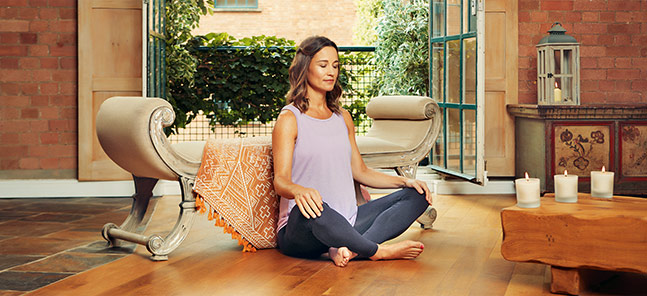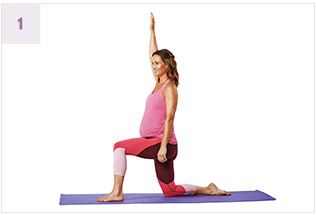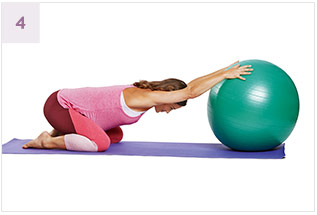

As our fitness columnist enters the last month of her pregnancy, stretching, meditation and walking are proving to be key parts of her daily routine
As the final month nears and the bump grows prouder each day, movement is certainly getting more awkward.
As a result, one of the biggest changes is that my lower body has tightened up. The knock-on effect is making my back and sacrum both uncomfortable and achy. The transformations to my body that are taking place as it prepares for childbirth have meant that the sound sleeps and the baby bubble effect have gone. Reality is finally kicking in.
Perhaps this is the body’s way of making sure that you get in tune with what lies ahead.
With this in mind, a few things have proven invaluable in keeping me feeling more supple and also clear headed in preparation for the next phase – birth and beyond. These include stretching, meditating and walking. Without those three things I would certainly not feel as good as I do right now, and I hope they will continue to keep me sane and levelled for the months and years ahead.
I signed up to a beginners’ meditation class recently to master the tools essential for performing it effectively. This involved learning to meditate twice daily, ideally for 20 minutes, chanting a mantra, while sitting upright, eyes closed and focused. Our teacher stressed that we should ensure we always make time for this because there’s always an excuse not to.
The idea is that your ‘meditation window’ takes your mind and body into a state of pure rest – better than the kind that sleep could give you. Most importantly, it allows an opportunity to restore and nourish both mind and body. I was sceptical at first, but after practising this discipline for the past month I have noticed a huge difference in my mental wellbeing and sense of clarity.
During pregnancy your body takes a lot of physical strain, particularly during the last trimester. At this latter stage, I’ve found it essential to stretch my hamstrings, hip adductors, hip flexors and lower back on a daily basis because these areas all have the tendency to get overly tight.
I’ve included here some of the stretches that I’ve found most useful recently. But any stretching – as long as you don’t overdo it (given that your body has more relaxin during pregnancy) – is good. Just make sure to include safe positions for your stage of pregnancy.
And there’s nothing better than a stimulating walk. Weaving this into your exercise routine will hopefully keep you feeling your best as your due date nears.
It’s a good idea to take some wellbeing time for mummy-to-be now and, most importantly, for the future.

Kneeling lunge with arm reach
Hold for 30-60 seconds each leg
Benefits: Stretches the hip flexors and glutes
Start by kneeling on your right knee with your left leg out in front. Tuck your hips underneath and squeeze your glutes as you lift your right hand over your head. Hold this position for a few seconds and then move your hips slightly forward and lean slightly to the left to really feel a stretch in the front of your body.

Bound angle pose
Hold for 30-60 seconds
Benefits: stretches the inner thighs and helps relax the hips
Sit with your legs bent and your heels pulled towards your pelvis. Gently lower your knees out to the sides as you hold both feet with your hands. Keep your back straight as you lean slightly forward. Stop when you feel the stretch and take deep breaths.

Hamstring stretch
Hold for 30 seconds each leg
Benefits: works the hamstrings and lower back
Kneel down on the floor so that your left knee is at a 90° angle and extend your right leg forward with a pointed foot. Lean forward over the right leg, placing both hands on your thigh for support. Feel the stretch, then hold and breathe.

Child's pose with ball
Hold for 30-60 seconds
Benefits: works your glutes and core
Place your gym ball in front of you with your hands resting on the top. Sit back onto your heels. Relax through your spine, from your neck down to your tailbone. Inhale deeply and as you exhale sink further back towards your heels.

Weekend’s fitness guru outlines how best to approach workout routines during the final month of pregnancy
Pippa has taken a proactive and positive approach to exercise throughout her pregnancy, which has helped provide a wonderful level of physical, mental and emotional wellbeing. This will be vital in the final month up to and including the delivery and on into motherhood.
In my book, Bump It Up, I dedicate significant attention to the final stages of pregnancy because this is the period of greatest physical and psychological stress for any mother-to-be. Pippa highlights a key rule – how vital it is to keep moving. With the ever-increasing bump and the associated challenges to the body and mind, aerobic endurance, strength and strength endurance are all crucial factors that will help during the delivery.
Pippa’s choice of walking is a fabulous way of keeping physically fit in her final month of pregnancy. She also highlights the importance of flexibility and mobility to help relieve stress on the back and hips, and in preparation for the birth. Relaxin – the hormone that increases joint laxity – peaks towards the end of the third trimester in readiness for the delivery. To that end, care needs to be taken to avoid overstretching because this can lead to joint injury.
Given the growing mental and emotional strain as the birth date approaches, taking the time to relax is valuable in reducing anxiety. Meditation is a wonderful way of easing this apprehension. There’s a range of antenatal exercise classes, including yoga, that can provide the time and space to be mindful, while keeping up flexibility, mobility, agility and strength. Pippa’s exercise programme has not only served to improve her pregnancy journey but will play a critical role during the postpartum period and beyond.










